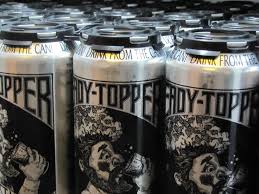 Last week someone brought me back a little gift from Vermont, and what a great one it was! It was none other than a can of Heady Topper from small and elusive brewery The Alchemist, based in Waterbury, Vermont.
Last week someone brought me back a little gift from Vermont, and what a great one it was! It was none other than a can of Heady Topper from small and elusive brewery The Alchemist, based in Waterbury, Vermont.
Like most beer aficionados I know Heady Topper’s reputation well. It is widely regarded as a superior Imperial Pale Ale. Yet, it is a very hard to acquire beer. In part because the family owners of The Alchemist are determined to stay small and to serve up only the freshest possible beer (they make only the one beer and sell it only in the surrounding region), and it is almost impossible to keep the beer on the shelves. You have to either be very lucky or very determined to get your hands on some.
Which means for most of us out these parts, the beer is a mere fantasy. So you can appreciate how thankful and excited I was to have some hand-delivered to my door. I definitely fit the “lucky” category!
So, does it live up to the hype?
It is a light gold colour and cloudy as hell – and they like it that way. It builds a sizeable, dense, pillowy white head and leaves significant lacing in the glass. The aroma is surprisingly balanced. I detect sweet white bread, soft fruit and a gentle, delicate fresh cut grass hop, accented by light citrus, some zesty lemon and a bit of grapefruit rind as well. Some yeast notes come through as well due to the lack of filtering.
The flavour starts with a soft, fruity malt. Nothing big here, just a bit of lemon drop and touches of light grain. The main flavour is a distinct, fascinating, complex hop flavour: light citrus, lemon, grass, lime, loamy earthiness, mango and pineapple. I take note that the beer is actually not that bitter and has a surprisingly light body. It is quite unlike most Double IPAs around. It is a deceptive beer. It tastes like a light fruit beer but with a more rounded, real character. And then there is the hop flavour which is multi-layered and, oh, so attractive.
One of the odd things about Heady Topper is that the can loudly instructs you to “drink from the can!”, in direct opposition to everything I understand about beer aromatics and flavour. Their logic is thus: “the act of pouring it in a glass smells nice, but it releases the essential hop aromas that we have worked so hard to retain.”
I wasn’t about to slurp back the entire beer – possibly the only one I will ever try – from the can, but I did have to see what they are on to. So I smelled the beer before pouring, and then poured half into a glass, leaving the remaining half in the can, allowing for something of a side-by-side comparison. I found the aroma was bigger and more complex in the glass, but the can did seem to draw out some of the sharper, piney character in the hops. In the can, the front end suffered, but I do admit that, surprisingly, drinking from the can did accent the hop flavours more. That said I preferred drinking it from the glass, which I found more complex and softer overall.
In the can or in the glass, there is no question in my mind that this is an original and captivating beer. It is unlike any Double IPA I have had, foregoing the hop bomb for something more subtle and multi-dimensional. They show that you can coax much more out of hops than citrus-y bitterness.
I fear I may be hooked on this beer, as I am already working out reasons to go to Vermont sometime soon.

Leave a Reply